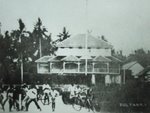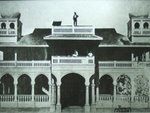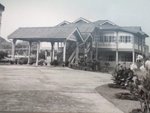[Note: I found this article on our national food 'Ambuyat' written for Denver Post by John Henderson and syndicated on the The Times of Zambia (of all place!)]
If Bruneians want to expand tourism, they’ll need to hide their national speciality.
I saw the sultan of Brunei the other day. He walked right by me as he entered a national Qur’an reading contest.
I wanted to ask the sultan a key question about his country’s cuisine: Hey, sultan, why can’t a man worth 22-billion, whose 400-million palace has a 110-car garage and 257 bathrooms, afford a better national dish?
It’s called ambuyat. Don’t look for it at an ethnic restaurant near you soon. It’s not going anywhere, and it’s here for reasons only historians and the streets’ starving cats can appreciate.
After four days in Brunei, I’d describe ambuyat (pronounced om-BOO-yacht) as a big pile of gelatinous, transparent goo dipped in coagulating blood.
First, a little background. During World War II occupation, the Japanese controlled Brunei’s rice paddies and cut off the food supply. One of the lone food sources was found inside the sago trees that fill Brunei’s jungles.
For centuries the Penan people, an indigenous, nomadic tribe who roam the jungles of Borneo, have lived off the sago tree. They still do. During a three-day trek through the jungles of Malaysian Borneo, I came across a Penan family squatting next to a stack of sago pulp.
They put what looked like leafy sawdust in a wooden bowl the size of a rubbish bin and pounded it into small chunks. They then mix it with hot water and the result is a starchy mass that has all the daily nutrients of raw lard.
Brunei, however, has advanced a bit since World War II. With the discovery of oil in 1929, Shell and the beloved sultan have put petrol in every pot. Shaped like two humps on a camel and occupying a small corner of Borneo’s northwest coast, Brunei has gone from a backwater British protectorate to a thriving Islamic republic of 375000 people with a glittering capital and prosperous economy.
Don’t believe me? What’d you pay for petrol this week? Exactly.
The sultan wants to expand tourism, and while he won’t open Hard Rock Brunei any time soon, he is promoting his country’s history. Part of that history is ambuyat. Tourism has grown 7% a year. I’m assuming ambuyat has nothing to do with it.
To try ambuyat, I went to a food-court stall where it was not pictured among the 31 dishes on the menu. No wonder. A picture in focus would scare off wharf rats.
Two young female cooks invited me into the kitchen to watch the process. It was little different from how the Penans make it. Ema poured a bag of sago that looked like blue-cheese crumbles into a pot of boiling water. She stirred for 60 seconds.
She handed me the result and the necessary dipping sauce, binjai, a gross mixture of chillies, salt and what looked like last week’s tomato soup. Hunks of bulbous matter floated in an orange- brown sea of repugnant fluids.
I was handed chopsticks , around which I was to twist the gooey ambuyat and then dip into the sauce.
The slimy mess slid down my throat like crushed, larvae-coated insect embryos. The sour binjai made my face wrinkle as if I woke up in a dairy farm. I looked over, and a young woman in a head scarf couldn’t stop laughing.
I tried it without the sauce and the ambuyat had no taste. None. But without the lubricating sauce, it nearly stuck halfway down my throat.
So hats off to Brunei for surviving World War II, where ambuyat was probably a tougher obstacle than the Japanese. But if the sultan invites you to the palace, forget the five swimming pools and 564 chandeliers. If ambuyat is on his menu, don’t go.
Welcome to my private journal generally on Brunei issues. Any opinions expressed are in my personal capacity. All rights to the articles are reserved.
Sunday, June 22, 2008
Friday, June 20, 2008
Brunei on the Bounding Main
[Note: The following was reported on Asia Sentinel written by John Berthelsen, 19th June 2008.]
The oil-rich sultanate is trying to sell 3 modern warships its navy can’t use .
Want to buy a high-speed warship, cheap, never used, bristling with some of the most advanced weaponry on the high seas? Three of them, in fact? Call Brunei. They can’t use them.
Ever since the sultanate settled a confidential contract dispute over the vessels in the International Court of Arbitration in June 2006, its navy has been trying to get rid of three 95-meter-long corvettes, built by BAE Systems of the UK. Since July 2007, they have been parked in Walney Channel near BAE’s shipyard at Barrow-in-Furness in northwest England while Brunei seeks a buyer. The price for the three is ₤600 million (US$1.71 billion).
They are now in the hands of the German luxury yacht builder Fr. Lürssen Werft GmbH & Co. KG, which has been looking for a buyer for more than a year, rather than a military broker. A Lürssen Werft spokesman, asked about the three ships, said he would inquire and get back to Asia Sentinel, but so far hasn’t done it. One source said the three ships are being offered to the United Arab Republic, possibly through sources in Singapore. Malaysia also is believed to have looked at them briefly.
“They have been taken away by the customer,” said a spokeswoman for BAE. “As I understand it, they are somewhere in the northwest, but they are not with BAE Systems. As far as the business is concerned, the customer took delivery. They are no longer moored with us.” She would not comment further.
The story began in 1995 when Brunei, which has only 66 miles of coastline, went looking for advanced protection for its 313,000 citizens, its oil reserves and its fabulously wealthy royal family. Brunei declines comment on its military affairs. But one source with connections to the Brunei government said that Sultan Hassanal Bolkiah is believed to have been swayed by a desire to project Bruneian naval power in an effort to hold the country’s portion of the much-disputed Spratly islands.
The Spratlys are a string of 51 small islands and reefs, 44 of which are claimed or occupied by every country contiguous to the South China Sea including China, the Philippines, Vietnam, Taiwan, Malaysia and Brunei, in a bid for fishing and energy rights. Brunei only recently became an active player in the Spratly dispute by claiming the Louisa Reef adjacent to its coastline in an apparent attempt to forestall any claims on its coast or its nine oil fields in the South China Sea, which average about 143,000 barrels per day.
Already protecting Brunei’s coast, according to some reports, are the Royal Brunei Navy’s three guided-missile patrol craft armed with MBDA Exocet antiship missiles, three smaller patrol boats, two amphibious craft, two landing craft, 17 small armed river boats used by the Special Combat Squadron, a support launch and 23 Marine police patrol boats.
The armaments aboard the three corvettes appear to be sophisticated enough to chase some of the other countries off whichever Spratly Brunei might decide it wants, let alone hold off any attackers likely to show up in Bruneian waters, situated as they are on the north coast of Borneo on the South China Sea. Aboard each of the three are these systems:
- NAUTIS II command and weapon control system;
- MBDA VL Seawolf point defence missile system
- Oto Melara 76/62 Super Rapid gun
- MBDA MM40 Block 2 Exocet anti-ship missiles
- two MSI-Defence single 30 mm REMSIG gun mountings
- two sets of triple torpedo tubes
- BAE Systems Insyte AWS-9 surveillance and target indication radar
- Ultra Electronics System 2500 electro-optical tracking system
- Thales Cutlass 242 electronic support measures outfit and Scorpion jammer
- Thales TMS 4130C1 hull-mounted medium-frequency sonar.
The Royal Brunei Navy’s current strength is about 750 personnel. Each of the three corvettes would require a crew of about 100 personnel and normal naval practice is to train at least two full crews per warship. The new ships would have required at least another 600 men for even the most basic operations, not to mention shore-based support personnel, according to a military analyst based in the UK, effectively requiring almost the doubling of the country’s navy.
“Operating and maintaining this kit would absorb much of Brunei’s small cadre of technically proficient workers, few of whom would be remotely interested in bobbing around the South China Sea being shouted at by people considerably less competent than themselves,” the analyst said.
Brunei refused to accept the ships in 2004, saying they were not up to specification, and attempted to return them to BAE systems. They were forced to take them in the wake of the court case.
But, said the military analyst: “Recognition (that the ships were too complex) came slowly to the sultan and his people, and when it did they first sought a face-saving deal – perhaps calculating that they could arbitrage the three patrol vessels against a possible order for jet aircraft also built by BAE. This clearly did not work and the issue went to law – with the outcome described above.”
Brunei, with its vast oil wealth, has always gone first cabin for military equipment, partly because of the sultan’s personal proclivities. A trip to the Singapore Air Show or other military hardware fairs by the sultan can turn into a show itself as various gun-runners, quick-change artists, armaments dealers and military attaches from countries trying to sell the sultanate hardware cluster around him like bees to extremely lucrative honey.
The sultan himself, educated at the British Royal Military Academy at Sandhurst, pilots his own helicopter. His air force consists mainly of helicopters -- six Sikorsky Blackhawks, five Bell JetRangers, 10 Bell Twin Hueys, six German MBB Bo 105 utility helicopters and a flock of other gear. Plans for fighter capability through the purchase of BAE Hawks apparently are off, presumably after the attempt to trade them for the corvettes fell apart.
The three ships may be hard to sell. According to a July 5, 2007 story in the Times of London, they were designed with doors and beds constructed for smaller, Asia-size sailors. Because they were designed for duty in the warm waters of the South China Sea, they also lack heating. Strategic considerations could also limit their sale. Given their state-of the art missile guidance and target-tracking systems, Exocet mountings and other hardware, the western alliance would frown if buyers from, say, North Korea, Burma or Iran were to express an interest.
The oil-rich sultanate is trying to sell 3 modern warships its navy can’t use .
Want to buy a high-speed warship, cheap, never used, bristling with some of the most advanced weaponry on the high seas? Three of them, in fact? Call Brunei. They can’t use them.
Ever since the sultanate settled a confidential contract dispute over the vessels in the International Court of Arbitration in June 2006, its navy has been trying to get rid of three 95-meter-long corvettes, built by BAE Systems of the UK. Since July 2007, they have been parked in Walney Channel near BAE’s shipyard at Barrow-in-Furness in northwest England while Brunei seeks a buyer. The price for the three is ₤600 million (US$1.71 billion).
They are now in the hands of the German luxury yacht builder Fr. Lürssen Werft GmbH & Co. KG, which has been looking for a buyer for more than a year, rather than a military broker. A Lürssen Werft spokesman, asked about the three ships, said he would inquire and get back to Asia Sentinel, but so far hasn’t done it. One source said the three ships are being offered to the United Arab Republic, possibly through sources in Singapore. Malaysia also is believed to have looked at them briefly.
“They have been taken away by the customer,” said a spokeswoman for BAE. “As I understand it, they are somewhere in the northwest, but they are not with BAE Systems. As far as the business is concerned, the customer took delivery. They are no longer moored with us.” She would not comment further.
The story began in 1995 when Brunei, which has only 66 miles of coastline, went looking for advanced protection for its 313,000 citizens, its oil reserves and its fabulously wealthy royal family. Brunei declines comment on its military affairs. But one source with connections to the Brunei government said that Sultan Hassanal Bolkiah is believed to have been swayed by a desire to project Bruneian naval power in an effort to hold the country’s portion of the much-disputed Spratly islands.
The Spratlys are a string of 51 small islands and reefs, 44 of which are claimed or occupied by every country contiguous to the South China Sea including China, the Philippines, Vietnam, Taiwan, Malaysia and Brunei, in a bid for fishing and energy rights. Brunei only recently became an active player in the Spratly dispute by claiming the Louisa Reef adjacent to its coastline in an apparent attempt to forestall any claims on its coast or its nine oil fields in the South China Sea, which average about 143,000 barrels per day.
Already protecting Brunei’s coast, according to some reports, are the Royal Brunei Navy’s three guided-missile patrol craft armed with MBDA Exocet antiship missiles, three smaller patrol boats, two amphibious craft, two landing craft, 17 small armed river boats used by the Special Combat Squadron, a support launch and 23 Marine police patrol boats.
The armaments aboard the three corvettes appear to be sophisticated enough to chase some of the other countries off whichever Spratly Brunei might decide it wants, let alone hold off any attackers likely to show up in Bruneian waters, situated as they are on the north coast of Borneo on the South China Sea. Aboard each of the three are these systems:
- NAUTIS II command and weapon control system;
- MBDA VL Seawolf point defence missile system
- Oto Melara 76/62 Super Rapid gun
- MBDA MM40 Block 2 Exocet anti-ship missiles
- two MSI-Defence single 30 mm REMSIG gun mountings
- two sets of triple torpedo tubes
- BAE Systems Insyte AWS-9 surveillance and target indication radar
- Ultra Electronics System 2500 electro-optical tracking system
- Thales Cutlass 242 electronic support measures outfit and Scorpion jammer
- Thales TMS 4130C1 hull-mounted medium-frequency sonar.
The Royal Brunei Navy’s current strength is about 750 personnel. Each of the three corvettes would require a crew of about 100 personnel and normal naval practice is to train at least two full crews per warship. The new ships would have required at least another 600 men for even the most basic operations, not to mention shore-based support personnel, according to a military analyst based in the UK, effectively requiring almost the doubling of the country’s navy.
“Operating and maintaining this kit would absorb much of Brunei’s small cadre of technically proficient workers, few of whom would be remotely interested in bobbing around the South China Sea being shouted at by people considerably less competent than themselves,” the analyst said.
Brunei refused to accept the ships in 2004, saying they were not up to specification, and attempted to return them to BAE systems. They were forced to take them in the wake of the court case.
But, said the military analyst: “Recognition (that the ships were too complex) came slowly to the sultan and his people, and when it did they first sought a face-saving deal – perhaps calculating that they could arbitrage the three patrol vessels against a possible order for jet aircraft also built by BAE. This clearly did not work and the issue went to law – with the outcome described above.”
Brunei, with its vast oil wealth, has always gone first cabin for military equipment, partly because of the sultan’s personal proclivities. A trip to the Singapore Air Show or other military hardware fairs by the sultan can turn into a show itself as various gun-runners, quick-change artists, armaments dealers and military attaches from countries trying to sell the sultanate hardware cluster around him like bees to extremely lucrative honey.
The sultan himself, educated at the British Royal Military Academy at Sandhurst, pilots his own helicopter. His air force consists mainly of helicopters -- six Sikorsky Blackhawks, five Bell JetRangers, 10 Bell Twin Hueys, six German MBB Bo 105 utility helicopters and a flock of other gear. Plans for fighter capability through the purchase of BAE Hawks apparently are off, presumably after the attempt to trade them for the corvettes fell apart.
The three ships may be hard to sell. According to a July 5, 2007 story in the Times of London, they were designed with doors and beds constructed for smaller, Asia-size sailors. Because they were designed for duty in the warm waters of the South China Sea, they also lack heating. Strategic considerations could also limit their sale. Given their state-of the art missile guidance and target-tracking systems, Exocet mountings and other hardware, the western alliance would frown if buyers from, say, North Korea, Burma or Iran were to express an interest.
Subscribe to:
Posts (Atom)






